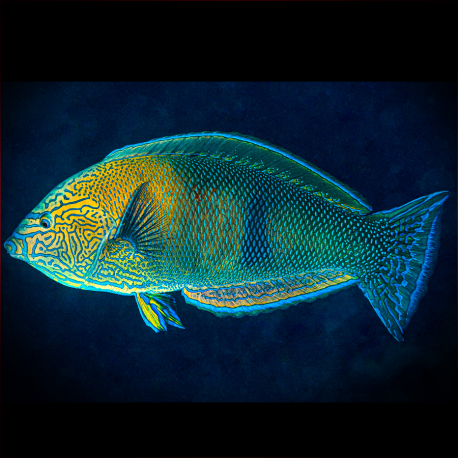More info
Datasheet
| Minimum Tank Size | 700 litres / 184.92 US gallons |
| Maximum Size | 31.0cm / 12.20inches |
| Reef Compatible | Reef safe with caution |
| Temperament | Docile but might be aggressive towards similar species of same gender |
| Temperature | 22.2°C / 71.96°F - 25.6°C / 78.08°F |
| Specific Gravity | 1.020-1.025 |
| Carbonate Hardness | 8-12 |
| pH | 8.1-8.4 |
General Description
The Geographic wrasse, also known as the Scribbled wrasse, Lined chisel-tooth wrasse, and Olive-green wrasse, belongs to the Labridae family, specifically the Anampses genus. These fish are widely distributed in the Indo-West Pacific region, ranging from Mauritius to Fiji, north to the Ryukyu Islands, south to Western Australia, and the Great Barrier Reef.
Aquarium Suitability
Aquarists should exercise caution when considering the Geographic wrasse for their tanks. These fish demand experience, preparation, and extra care due to their specific needs and behaviors. They acclimatize best as juveniles and are known to be sensitive during transport and acclimatization into the aquarium. They do best as a pair with one male and one female or with one male and several females.
Demands, Care, and Hardiness
With an average hardiness level, Geographic wrasses are docile but may exhibit aggression towards similar species of the same gender. They prefer a deep sandy substrate of at least 2 inches to burrow when afraid or resting. These fish are sensitive and require frequent feeding, especially when newly introduced. Providing live food enhances their adaptation to tank life.
Reef Suitability
Reef aquarists can consider the Geographic wrasse as reef-safe with caution. While they are generally peaceful towards other tank mates, smaller invertebrates can be at risk due to the species' predatory nature.
Aquarium Setup
When setting up a tank for Geographic wrasses, a minimum tank size of 700 liters is recommended to accommodate their potential size of up to 31.0 cm. The tank should include a deep sandy substrate, hiding spots, and peaceful tank mates. Maintaining water conditions with a pH of 8.1-8.4, a temperature range of 22.2-25.6°C, and a specific gravity of 1.020-1.025 is crucial for their well-being.
Behaviour
Geographic wrasses are generally shy and docile fish that may bury themselves in the sand when threatened or in need of rest. They are known to be peaceful towards other tank inhabitants and thrive best in small groups with minimal aggression.
Feeding and Diet
These wrasses have a varied diet that includes larger crustaceans, other invertebrates, small crustaceans like krill and mysis, and zooplankton such as Cyclops and pods. Feeding them live food and offering multiple feeding times per day enhances their health and well-being.
Dimorphism and Captive Reproduction
Geographic wrasses exhibit dimorphism between males and females, with females being able to change gender to male when necessary. These fish are challenging to breed in captivity due to their specific reproductive behaviors and requirements.
Habitat and Distribution
Native to the Indo-West Pacific, Geographic wrasses inhabit reefs from Mauritius to Fiji, venturing as far north as the Ryukyu Islands and as south as Western Australia. They have been recently spotted in Tonga, showcasing their wide distribution in the region.

